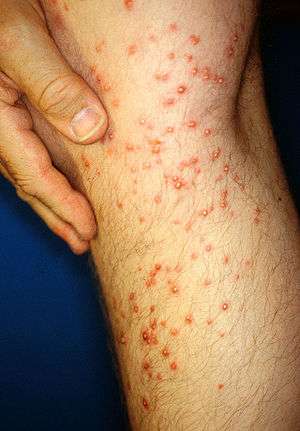Ant venom
| Ant venom | |
|---|---|
|
Sterile pustules 3 days after fire ant stings. | |
| Classification and external resources | |
| ICD-10 | X25 |
| ICD-9-CM | 919.4, 989.5 |
Ant venom is any of, or a mixture of, irritants and toxins inflicted by ants. Most ants spray or inject a venom, the main constituent of which is formic acid only in the case of subfamily Formicinae.
Ant stings
There are only rare examples of stinging ants. Some notable examples include Solenopsis (fire ants), Pachycondyla, Myrmecia (bulldog ants), and Paraponera (bullet ants). In the case of fire ants, the venom consists of alkaloid and protein components. The stings cause cutaneous condition caused by stinging (as distinct from biting) venomous ants. Particularly painful are stings from fire ants, although the bullet ant's sting is considered by some to be the most painful insect sting.[1]:450
First aid for fire ant bites includes external treatments and oral medicines.
- External treatments: a topical steroid cream (hydrocortisone), or one containing Aloe vera[2]
- Oral medicines: antihistamines
- Applying zinc oxide or calamine lotion .
Severe allergic reactions can be caused by ant stings in particular and venomous stings in general, including severe chest pain, nausea, severe sweating, loss of breath, serious swelling, fever, dizziness, and slurred speech;[3] they can be fatal if not treated.
See also
- Acidopore
- Poneratoxin
- Pulicosis (flea bites)
- Skin lesion
References
- ↑ James, William D.; Berger, Timothy G.; et al. (2006). Andrews' Diseases of the Skin: clinical Dermatology. Saunders Elsevier. ISBN 0-7216-2921-0.
- ↑ Bastiaan M. Drees (December 2002). "Medical Problems And Treatment Considerations For The Red Imported Fire Ant" (PDF). Texas A&M University. p. 4. Retrieved 2009-09-09.
- ↑ "Insects and Scorpions". The National Institute for Occupational Safety and Health. 2008-10-22. Retrieved 2008-11-04.
